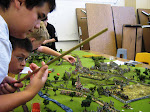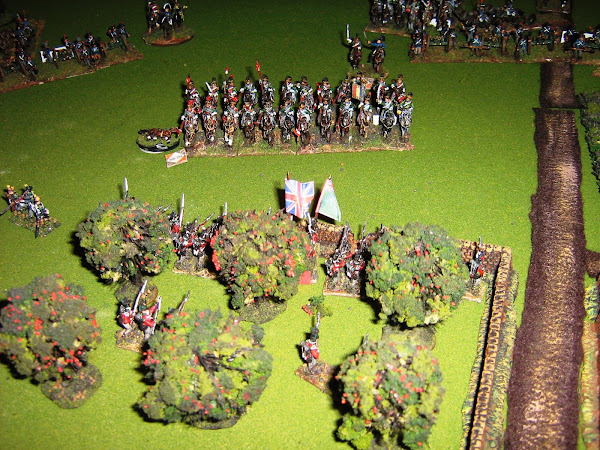I have really enjoyed playing the General de Brigade rules. The after action reports I have read have helped me understand the finer points, as did the sample battle in the rule book. I thought I would add my own tutorial for anyone interested in getting a better grip on how the rules work. My intent is to go step by step in each turn and have photos of what actually happened so that there is a clear mental picture of how things work.
The set up- Of course, there needs to be a scenario for the battle. In this case, I am trying to recreate the opening moves the eventually led up to the Battle of Waterloo. A French division under General Foy has advanced across the frontier and is attempting to capture a small but vital hamlet. The Dutch/Belgian brigade of Prince Bernhard of Saxe-Weimar from the division of Lt. General Perponcher is defending the hamlet.
The first step in starting the game is issuing orders. In this case, General Perponcher has chosen to defend the hamlet and has given Prince Bernhard a "hold" order.
 |
| It's a bit blurred, but this is Perponcher's stand with a "Defend" order next to it. |
 |
| Prince Bernhard is up with his artillery and has the "hold" order next to him. |
General Foy is eager to push the Dutch/Belgians aside, so he has given his division an "Attack" order. He has instructed both of his brigades to "assault." This is the most aggressive order that can be given.
 |
| General Foy and his "attack" order. |
 |
| General Jamin commands the brigade on the French right and will be attacking across relatively open ground. |
 |
| General Gauthier is on the left and has a forest to negotiate before he can get at the enemy. |
The game is now ready to begin. The first step is to determine initiative. Both sides roll two D6. The French get to add one to their total. The higher number decides who gets the initiative. The winner can choose to go either first or second.
 |
| General Perponcher rolls a seven. |
 |
| General Foy rolls a ten and adds one. His 11 beats the 7, so he can choose to go first or second. He wants to go first. |
The next step of the turn is compulsory moves, but there aren't any at this stage, so we move to the next phase which is orders. Both sides have already issued orders and neither wants to try to change any, so we move on to charges. No units are close enough to charge; this phase is skipped and now it is time for movement. Foy, having won the initiative, gets to move first.
 |
| Jamin's men are in column and skirmish order, so they can move 15cm. |
 |
| Here the units have all been moved. There are five elements in this brigade, the four battalions in column and the skirmish screen. |
 |
| Gauthier's men are also set to move, but in his case, his left-hand regiment, the 4th Legere, has to move through a wood. It's movement is halved. |
 |
| The legere battalions will move at half speed through the wood. |
The Dutch/Belgians choose not to move this turn.
Now comes the firing. Foy gets to fire first. He begins with his artillery which shoots at the Dutch horse artillery.
 |
| The French roll |
Foy rolls a four. This is modified with a -2 since the Dutch guns are deployed. In consulting the fire results table for a total of two for four guns, we see that there are no hits. But now the skirmishers can take a shot. Six of them are in range and therefore get to throw two dice.
 |
| A six and a one. The skirmishers hit the battery one time. |
 |
| The Dutch battery has been issued a marker showing that it has been hit one time. |
The rest of the French skirmishers are either out of range (not within 20cm) or miss.
Now it's the Dutch turn to fire. Perponcher directs his battery to fire at one of the advancing columns. It is not yet in cannister range, but it is still in close range. The battery gets to add one to its roll since the target is in column. A nine is rolled, plus one equals 10. The chart is consulted and a 10 from 4 guns equals 2 hits.
 |
| The Dutch guns fire. |
 |
| The French column is marked with two hits. |
The firing is concluded. There are no melees to resolve and no morale checks to be taken, so the first turn is over.
Turn two-
Both sides roll for initiative. Foy rolls a total of six and adds one for being French. Perponcher rolls an eight and thereby wins initiative. He elects to go first. There are no compulsory moves and neither side wants to attempt to change any orders. Both sides are still out of charge range, so it's time for movement. Perponcher's only move is to pull back a small unit of jagers on his extreme right flank. Foy, on the other hand, advances all of his units the maximum distance.
 |
| The French legere continue to move through the woods. |
 |
| The other French brigade advance quickly across the open ground. |
 |
| Dutch jagers to be moved back. |
It is now the fire phase. The Dutch/Belgians get to fire first. They start with the artillery and shoot at the advancing columns. They are not allowed to split their fire, and so all four guns fire at once and the casualties are distributed as evenly as possible between the two targets which are in cannister range. A seven is rolled. It is modified with a plus 4 for firing cannister and a plus 1 for firing at a column. The total of 12 for four guns equals three hits. The skirmish screen takes the first hit and the column behind it takes the second. The other column loses one of its skirmisher figures.
 |
| The hits are recorded on the advancing French column. The first casualty is applied to the skirmish screen. |
The Dutch skirmishers fire, but don't get any hits.
It is now the French turn to fire. The medium battery again targets the Dutch guns. Snake eyes are rolled, which means the battery is now low on ammo and will fire at half its effectiveness for the remainder of the game. The two is reduced by two more for firing at the deployed guns. No hits. But the French skirmishers fire as well and get another hit on the battery. Shots at the opposing Dutch/Belgian skirmisher all miss their mark.
 |
| The Dutch battery is hit by the skirmishers and so the die is changed from a one to a two. |
The firing is now concluded. There are no melees or morale checks, so the second turn is over.



























































